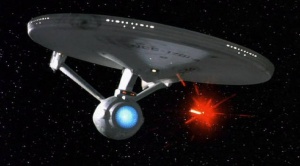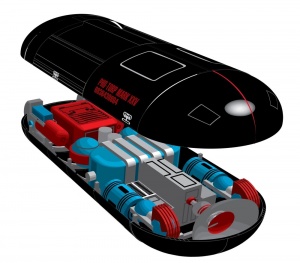Photon Torpedo
More actions

It has been generally accepted that the photon torpedo is the weapon of choice for warp velocity ship-to-ship conflict, as well as the delivery system for non-standard warhead packages. Ship mounted phasers have traditionally been of little use during warp flight, due to the light speed barrier for EM energy. Recent developments in subspace technology have pushed the phaser into the FTL arena, but the photon torpedo is still more favorable followed on by the higher energy Quantum Torpedo.
In launches from space stations or sub light star ships, the initial velocity remains at high sublight and will never reach warp 1. This does not imply that the torpedo is impractical for station defense; it has been shown that even at low impulse the standard photon torpedo is effective against close in threat vessels.
The basic external configuration of the photon torpedo carried on board star ships and space stations has changed little from 2271 to 2375. The body is an elongated elliptical tube fabricated from moulded gamma expanded duranium and a plasma bonded titanium outer skin. The current casing measures 2.1 by 0.76 by 0.45 meters and masses 186.7 kilograms dry weight, slightly less than the previous design. The standard internal components include deuterium and anti-deuterium supply tanks, central combiner tank and their respective magnetic suspension components: target acquisition, guidance, detonation assemblies and warp sustainer engine.
Photon Torpedo Configuration

- Outer casing
- The standard photo torpedo casing is 2.1 x 0.76 x 0.45 meters and is constructed of of molded gamma expanded duranium plasma-bonded terminium outer skin. The casing is fabricated as a shingle unit that is split in two halves with phaser cutters. The unit is cut along the equatorial line by phaser cutters. These cutters are also used to cut the required penetration for reactant injections and ODN connections and propulsion exhaust.
- Holding Tanks
- The deuterium and antideuterium tanks are constructed of hafnium titanide lined with directionaly cast silicon-copper carbide. The antideuterium holding tank has a third inner layer of ferric quonium to provide the required magnetic isolation of the antideuterium.
- Central Combiner Tank
- The combiner tank is also constructed of hafnium titanide outer shell with a silicon-copper carbide mid-layer and ferric quonium inner layer. Prior to detonation the matter and antimatter are shunted from the holding tanks to the combiner tank. The matter and antimatter is separated into several thousand minute packets in creasing the annihilation surface. Just prior to the point of detonation the magnetic fields separating the matter and antimatter drop causing the reactants to mix resulting in the required explosion of 18.5 isotons.
- Targeting and Control Assemblies
- The targeting and control assemblies are two different sub-assemblies working in tandem to direct the torpedo to the target. The first is the targeting scanners and the other is the isolinear control module.
Prelauch trajectory instructions are uploaded to the ICO via OND connect points while in the torpedo launcher. After launch the torpedo will automatically track the target via the on board targeting scanners. If necessary the torpedo's trajectory can be updated if via subspace comm link.
At 3 seconds prior to target impact the ICO signals the torpedo's systems to shunt the matter and antimatter from the holding tanks to the combiner tank and at 0.45 seconds to impact it signals the magnetic fields within the combiner tank to drop.
- Warp Sustainer Engine
- The warp sustainer engine is not a true warp engine due to the WSE not having the ability to drive the torpedo beyond the speed of light. The WSE is powered by diverting some of the matter and antimatter from the holding tanks. The WSE consists of a reaction chamber of Hafnium. The resulting plasma is feed to the sustainer coils flanking the reaction chamber. The coils are constructed from verterium cortenide.
If the torpedo is launched while the ship is travailing at warp speeds the WSE will grab and retain a portion of the vessels warp field allowing the torpedo to remain at warp once outside the area of space affected by that warp field. If launched at impulse speeds the WSE will drive the torpedo at sublight speeds.
The current photon torpedo has a range of 4,050,000 kilometers, this is up form the max range of 3,500,000 kilometers of torpedo used prior to 2371. This is due to the increased size of the holding tanks that was made possible due to the new targeting and guidance assemblies installed into torpedoes starting in 2371.
Use of Bravo Fleet's Photon Torpedo is used under the Creative Commons 4.0 License and may have been modified for AioRPG.
